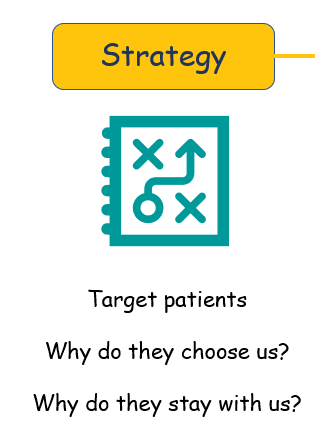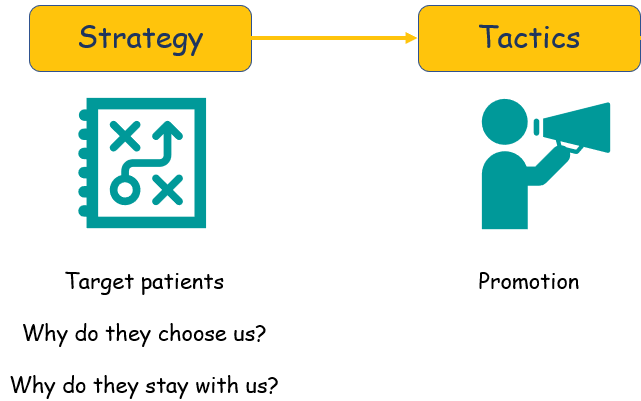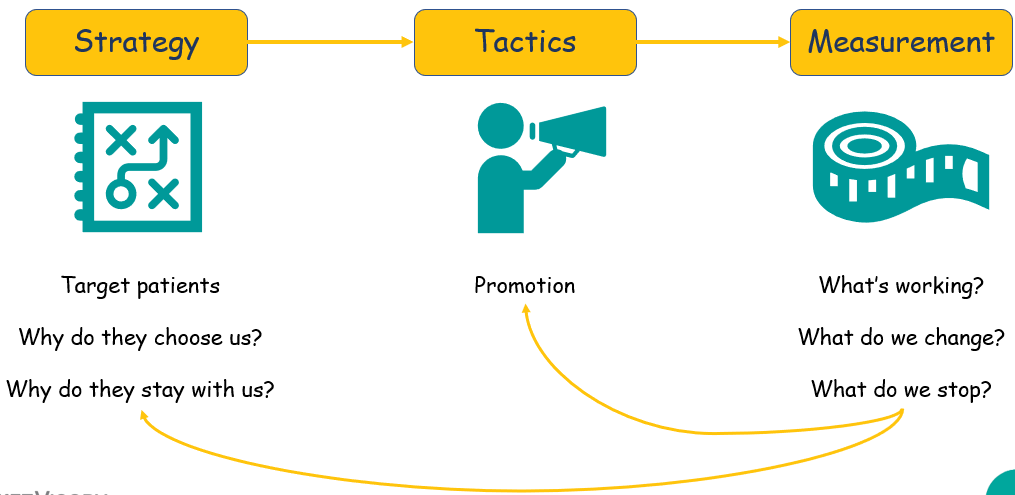Welcome to Healthcare Marketing Rx, where we help healthcare practice owners, practice managers – the decision makers – make good decisions about the marketing that they want to do for their practice.
This is not a how to. There’s an ocean of really good, how to information about almost anything you want to learn. We don’t think we can add anything to that. However, what we don’t see much good information on is how to make decisions about marketing. You won’t be doing the work. If you want to give some marketing to your staff, hire an outsource outside agency, this video series will help you figure out what good looks like.
We’re going to focus on starting to figure out how much you should spend on marketing your practice. We’re going to give you a couple of different frameworks – what you should think about. This is not about spreadsheets. This is not a calculation exercise. This is the conceptual level to help you make sure that you’re making a good decision and that you’re factoring in the important parts.
What’s Included in a Healthcare Marketing Budget
What’s included in a healthcare marketing budget? Broadly speaking, there are three categories of marketing work that you want to include.
Marketing Strategy
The first one is strategy.

This is where you ask questions about who are our target patients, and what’s really on their mind. Why do they choose us? Why do they stay with us? There’s other questions like that, but don’t overlook this. No matter what type of practice you are. For example, one of our clients is an OB GYN practice. It’s very clear who their target patients are on the surface. But nevertheless, there are some reasons why the patients that we get choose us and the patients that we don’t get choose others. There is some strategy work to do because what we try to get the ones who choose us and try to change the minds of those who don’t. But if you’re applying everything the same to everybody, then you’re not really going to get to, you know, that kind of different strategy level work.
Marketing Tactics
The second is tactics, which by and large means promotion.

Think of promotion very broadly. This could be everything from your website to paid advertising to SEO to getting reviews from your happy patients, which is as much of a referral sort of approach of promotion as it is anything else. Nevertheless, think of promotion pretty broadly for the purposes of this.
Measurement
The final part is measuring it all.

If you’re not measuring what you’re doing, you can’t ever make it better. What’s working. Is there anything we want to change? Is there anything we think we should stop? Is there anything we ought to start? That’s something that we do with our clients. We measure everything every month and we adjust on the fly. We make some changes sometimes to the strategy level, sometimes to the tactical level, but the saying of you can’t manage what you don’t measure is absolutely true. Make sure that you’re baking in some, some budget for measurement.
Healthcare Marketing Budget = Money and Time
Now, the total healthcare marketing budget that you’re going to think about, it includes all the resources.

Most people commonly think about money. Do I have enough money for this? Do I have enough money for that? That’s part of it, but the rest is your time, your effort, the time and effort of your staff that counts too. Taken together, the amount of money that you have and the amount of time and effort that you have, must equal the total amount of marketing in order to achieve the goals for the practice.
If you have a thin dollar budget, then you have to compensate that with time and effort. If on the other hand, you’ve got a pretty healthy money budget, then you probably don’t need as much time and effort. We offer a range of healthcare marketing systems to fit any budget.
Healthcare Marketing Budget – Conventional Wisdom
Let’s look at a couple of different ways to get started on figuring out what your budget could be.
Let’s start with the conventional wisdom approach – how much money does conventional wisdom say you should spend there?
It isn’t a hard and fast answer. The reason is there’s a lot of it out there. Some of it’s pretty good and some of it’s not so good. When I research different sources – everything from the small business advisory council, chamber of commerce, even some some medical association sites, there’s a pretty wide variety.
The most common recommendations I see is somewhere between 5% and 12% of annual collected revenue. That’s the money that actually comes in. If you bill insurance you usually don’t get what you charge. You get the negotiated rate. So only use collected revenue, the money that actually comes in the door. There are others that say lower than 5% and higher the 12%, but they don’t really help.
Conventional Wisdom for Conventional Practices
Something to know about conventional wisdom is that it applies to what I call, more conventional practices – an established practice who needs modest growth. What does modest mean? There’s no hard definition. It means more than flat. It means less than hypergrowth. But you want to grow a bit every year either because you need to replace patient churn, or because you want to be bigger at the end of the year.
Use Conventional Wisdom to Get Started
Conventional wisdom isn’t a bad place to start your planning. Why? Because you need some place to start. If you’re trying to figure out a healthcare marketing budget and you’re staring at a blank sheet of paper or a spreadsheet with nothing in it, you got to start somewhere. You might as well pick here. It’s easier to react to something on paper than it is to stare at a blank sheet of paper.
And you still may need to supplement with some time and effort with them. When you get through this exercise and you say, yeah, let’s try 5%. Let’s try 12%. Let’s see where it gets us. Let’s see what it looks like. You still may need to supplement with time and effort on your own or somebody on your staff. Just be ready for it. We don’t have any clients who actually do nothing. They’re still involved in the marketing plans that we put together. We need them to react to things. We need them to review things. It’s not a lot of time, but it’s also not zero. So that’s conventional wisdom.
What’s an obvious exception to conventional wisdom?
Exception to Conventional Wisdom– You’re Starting Something Up
If you’re starting something up, if you are all, but ignore conventional wisdom. You can start there. Like I said, but you’re not going to end up with 5% to 12%. For one thing, the math doesn’t work.
If you’re starting up a practice or you’re starting up, anything else, you probably don’t have much revenue yet. So five to 12% of nothing is nothing. That’s obviously illogical. And so you’re not going to end up there. Suppose you’re starting up a new practice. If you’re like a lot of new practices, you might have a very tiny money budget, which just means that the time and effort that you put into it has to compensate.
Established Practices Start New Things Too
It could also be an established practice, but you’re launching something new. Maybe you’re opening a new office. Maybe you’re adding new treatments. Maybe you’re adding new doctors. We highly recommend that, even though the rest of the practice is established, that you think of these as startups Go through the strategy, tactical, and measurement stages and fund them accordingly. The rest of the practice can go along with conventional wisdom or with whatever your current budget is.
However, applying a budget for an established practice to something that is not yet established is really going to hobble what you’re starting up. Once it catches up to the rest of the practice, you can change the budget and right-size it accordingly.
Exception for Conventional Wisdom – You’re Happy with your Practice’s Size
On the other end of the spectrum, what if you’re happy with your patient flow? What if your modest growth needs are even smaller than modest? Well, then we say, check your math on the conventional wisdom. You might end up at a 5% to 12% or 4% to 10%, but you might not. You should approach this differently because this is another example of not modest growth needs, right? It doesn’t fit that description.
Example – You have a large Referral Base
A couple of examples. One is a practice that has a large referral base.

The easiest example is an orthodontist in a community where a number of general dentists refer a lot of patients to that orthodontist. And that could be really taking care of the patient flow that makes the orthodontist practice owners happy with what they’re getting.
Example – You have a loyal Patient Base
The other example is where the patient base is really loyal and they’re an annuity patient model.

All that means is the patients come back year after year. They have to continue to get checkups and they stay with you. A very easy example is a general dentist. As long as the patients come in twice a year for a teeth cleaning, and if there’s a large enough patient base in total, then typically some other things will be found that have to be worked on from time to time. Those
In these cases, the priority for your budget is to keep those referral sources and those patients happy because they are the source of your new patients. You don’t need as much focus on promoting. You still need some, but we don’t think you need as much. But overall, because your priorities might be different than what you saw earlier, that doesn’t necessarily mean that you’re going to spend more or less on your marketing in time and money. It’s just that you don’t quite fit the mold of what we talked about earlier.
But I can tell you that we have clients for whom none of this works.
When All Else Fails and You Can’t Seem to Get Started…
We went through these questions. What do you think of this? What do you think of that? We start cooking up some spreadsheets and work with clients and they still don’t know. It’s more common than you think. If you say none of this is really working for me, then we have what I call the failsafe method of getting started with building a healthcare marketing budget overall.
It focuses on one simple question.
How much are you willing to spend in time and money and still be able to sleep at night?
It’s the sleep at night test. The reason this question works well for some of our clients is because one, it helps them arrive at a number. It’s something more tangible that they can wrap their arms around.
It acknowledges the fact that the owner of the practice is inexplicably tied to the financials of the practice. They can have a sense of, well, if I spent that much more money, then I’d still be okay. And then they can arrive at least at the beginning of a number. Then when they talk to people like me to outsource marketing, my job is to see if I can make that number work. If I can live within the number, great. If not, I come back to them and we’d see if we can make a match with a different number.
If nothing else works, then come to this. Even if you use this at the end, even if you started with say conventional wisdom, 5% or something else, or you’re a startup, and you’re looking at different numbers, you’re going to arrive at a number. Then stare at that number and say, well, can I sleep well at night? If I was spending this over time, once a month, every month, would I be up all night worrying? It’s better to get it out at the beginning rather than get into it and worry about it the whole time.
How do you actually get started building your healthcare marketing budget? Here are the steps:
- What are you marketing startup or something established?
- Start with that conventional wisdom, at least the idea of it, and then adjust it to your specific situation.
- Can you sleep well at night with what you just adjusted? Remember, don’t forget about time and effort. I know it’s hard particularly with the sleep at night test, but don’t lose sight of that.
- Get going. There’s only one way to find out if what you’ve, what you’ve created for a healthcare marketing budget is viable and let’s do it for a while. Nothing’s set forever. It’s not like you’re carving it in stone, never to be changed. You can change anything you want whenever you want, whenever you need to. The only way to find out if something’s really working is to do it for a little while and then figure out, see what’s working.
That’s our 2 cents on getting started, building your healthcare marketing budget. Our library of Healthcare Marketing Rx videos for practice owners for decision-makers and, and practice managers is growing.
MarketVisory Group is a Healthcare marketing agency. For more information, please contact us.
